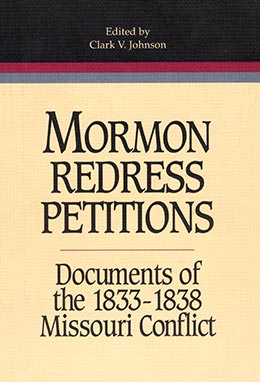Introduction to Part IV
Introduction to Part IV in Mormon Redress Petitions: Documents of the 1833–1838 Missouri Conflict, ed. Clark V. Johnson (Provo, Utah: Religious Studies Center, Brigham Young University, 1992), 563.
In 1844 Church leaders submitted at least three documents to Congress: a memorial asking that Nauvoo be made a territory of the federal government, an appeal to settle land in the Oregon Territory, and a memorial applying to Congress for redress for sufferings in Missouri (HC 6:131; Hyde, 11 June 1844; Congressional Globe 13:605).
Rather than submitting individual petitions, Church leaders sent a single petition in the final appeal. It was 50 feet long and rolled up like a scroll. After a brief, four-page introduction summarizing the sufferings of the Latter-day Saints in Missouri, 3,419 people signed their names. Some signed the petition more than once. Not all of the signers had been in Missouri, but signed the petition in support of those who had suffered there.
The scroll petition was prepared in the late fall of 1843 in Nauvoo (HC 6:88). Unlike most of the individual petitions, it was not notarized or sworn to before legal authorities. The Nauvoo City Council voted that Orson Pratt should “present the Memorial and Ordinance to Congress” (HC 6:124). Two other emissaries, Apostles John E. Page and Orson Hyde, helped Pratt present the Mormon cause in Washington during the winter and spring of 1844 (Page; HC 6:286).
Once again Church leaders secured the help of Illinois congressmen such as Senator James Semple, who previously had helped the Mormons (Congressional Globe 13:497, 13:605, 13:694). Of the ten representatives Illinois had in the House at this time (Bateman and Selby 446), it is most likely that Church leaders solicited help from John T. Stuart, Stephen A. Douglas, and John Wentworth. These three men were previously acquainted with the Saints (HC 4:356–57, 535–36; Wentworth). This time, however, the Saints did not have the help of their former advocate, Richard M. Young for by 1844, he was no longer in the Senate.
This scroll appeal fared no better than the others. On 9 June 1844, Orson Hyde wrote to Joseph Smith that Congress had rejected their plea to present the petition (Hyde). Still, Hyde had not given up, and he appealed directly to President John Tyler. In a letter dated 11 June 1844, he reported that President Tyler spent a “good deal of time with [me]” and “was very frank . . . but seemed to feel that I should be satisfied with a few words because of the press of business.” Continuing, Hyde explained, “We are now thrown back upon our own resources. We have tried every department of government to obtain our rights, but we cannot find them” (Hyde).
